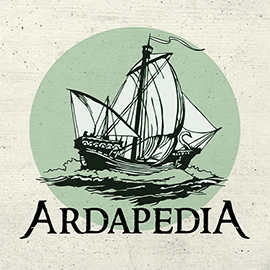Die letzte Reise von Earendel: Unterschied zwischen den Versionen
| Zeile 10: | Zeile 10: | ||
==Das Gedicht <ref>https://tolkiengateway.net/wiki/%C3%89al%C3%A1_%C3%89arendel_Engla_Beorhtast zitiert nach der Fassung auf tolkiengateway</ref>== | ==Das Gedicht <ref>https://tolkiengateway.net/wiki/%C3%89al%C3%A1_%C3%89arendel_Engla_Beorhtast zitiert nach der Fassung auf tolkiengateway</ref>== | ||
Éarendel arose where the shadow flows<br> | |||
at Ocean's silent brim; | |||
at Ocean's silent brim;<br> | |||
through the mouth of night as a ray of light | through the mouth of night as a ray of light | ||
where the shores are sheer and dim | where the shores are sheer and dim | ||
Version vom 14. April 2023, 11:36 Uhr
Die letzte Reise von Earendel ist die die deutsche Übersetzung von The Voyage of Eärendel the Evening Star. Es gibt nach Christopher Tolkien fünf Fassungen des Gedichtes[1]. Er stimmt mit Humphrey Carpenter darüber ein, dass die früheste Fassung im September 1914 entstand und es das erste Gedicht über Earendel/Earendil darstellt.[2] [3] Sein damaliger Titel lautet "Éalá Éarendel Engla Beorhtast" Es ist in vollem Umfang in The Book of Lost Tales Part Two[4] auf den Seiten 349 bis 350 veröffentlicht. Tolkien merkt in einem Briefentwurf an, dass der Ausspruch Heil Earendil hellster Stern bzw. Aìya Earendil Elenion Ancalima entfernt an diesen Titel erinnert. Der Name konnte allerdings laut Tolkien nicht beibehalten, sondern in die Sprachsituation des Elbischen eingefügt werden.[5]
Das Gedicht trug ursprünglich den Titel Die Fahrt von Earendel bzw. The Voyage of Éarendel the Evening Star mit der altenglischen Version Scipfæreld Éarendeles Ǽfensteorran. Tolkien verfasste es auf der Phoenix Farm seiner Tante Jane, inspiriert von einer Zeile aus dem Crist des Cynewulf.[6] Unter diesem Titel las Tolkien das Gedicht im November desselben Jahres im Oxford Essay Club und im Anschluss wurde es gut besprochen, wie Tolkien in Brief 2[7] ausführt.
In der letzten Überarbeitung, die zu einem unbekannten Zeitpunkt, aber "wesentlich später" als die erste geschrieben wurde, wurde der neuere Titel nur in seiner altenglischen Form angegeben. Dieser altenglische Titel wurde dem Gedicht entnommen, das ihn inspirierte und das im modernen Englisch als The Last Voyage of Eärendel[1]:348 wiedergegeben wird.
Es war das erste Gedicht über Eärendil und beschreibt seine Reise von "Westerland" durch "den dunklen Westen" und schließlich über die Welt hinaus. Die vierte Strophe beschreibt die Bewegungen von Sonne und Mond in einer Weise, die die Kosmologie von Die Verhüllung von Valinor und Die Geschichte von Sonne und Mond vorwegnimmt. Carpenter geht davon aus, dass dies der Anfang von Tolkiens Mythologie ist.
Das Gedicht [8]
Éarendel arose where the shadow flows
at Ocean's silent brim;
through the mouth of night as a ray of light where the shores are sheer and dim he launched his bark like a silver spark from the last and lonely sand; then on sunlit breath of day's fiery death he sailed from Westerland.
He threaded his path o'er the aftermath of the splendour of the Sun, and wandered far past many a star in his gleaming galleon. On the gathering tide of darkness ride the argosies of the sky, and spangle the night with their sails of light as the streaming star goes by.
Unheeding he dips past these twinkling ships, by his wayward spirit whirled on an endless quest through the darkling West o'er the margin of the world; and he fares in haste o'er the jewelled waste and the dusk from whence he came with his heart afire with bright desire and his face in silver flame.
The Ship of the Moon from the East comes soon from the Haven of the Sun, whose white gates gleam in the coming beam of the mighty silver one. Lo! with bellying clouds as his vessel's shrouds he weighs anchor down the dark, and on shimmering oars leaves the blazing shores in his argent-timbered bark.
Then Éarendel fled from that Shipman dread beyond the dark earth's pale, back under the rim of the Ocean dim, and behind the world set sail; and he heard the mirth of the folk of earth and the falling of their tears, as the world dropped back in a cloudy wrack on its journey down the years.
Then he glimmering passed to the starless vast as an isléd lamp at sea, and beyond the ken of mortal men set his lonely errantry, tracking the Sun in his galleon through the pathless firmament, till his light grew old in abysses cold and his eager flame was spent.</poem>
Das Gedicht in den Briefen Tolkiens
Tolkien geht in folgenden Briefen auf das Gedicht ein:
- Brief 2 hier unter dem Titel The Voyage of Éarendel the Evening Star
- Brief 297 hier unter dem Titel Éalá Éarendel Engla Beorhtast
Quellen
- ↑ Christopher Tolkien (Herausgeber), J. R. R. Tolkien (Autor), Das Buch der verschollenen Geschichten Band 2, Klett-Cotta 1999
- ↑ Carpenter, Humphrey. "J.R.R. Tolkien: Eine Biographie, Klett-Cotta 2022, S. 117f
- ↑ Christopher Tolkien (Herausgeber), J. R. R. Tolkien (Autor), Das Buch der verschollenen Geschichten Band 2, Klett-Cotta 1999 S. 348
- ↑ Christopher Tolkien (Herausgeber), J. R. R. Tolkien (Autor), Das Buch der verschollenen Geschichten Band 2, Klett-Cotta 1999
- ↑ J. R. R. Tolkien Briefe, 4. deutsche Auflage, Klett-Cotta S. 502
- ↑ Carpenter, Humphrey. "J.R.R. Tolkien: Eine Biographie, Klett-Cotta 2022, S.106 und S. 117ff
- ↑ J. R. R. Tolkien Briefe, 4. deutsche Auflage, Klett-Cotta S. 14
- ↑ https://tolkiengateway.net/wiki/%C3%89al%C3%A1_%C3%89arendel_Engla_Beorhtast zitiert nach der Fassung auf tolkiengateway
